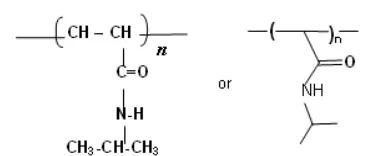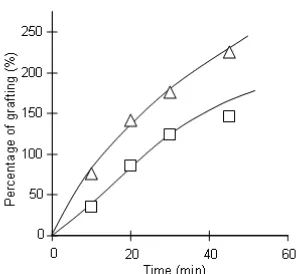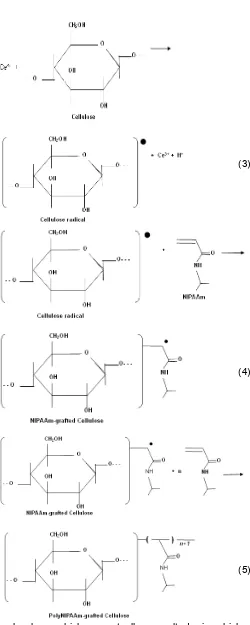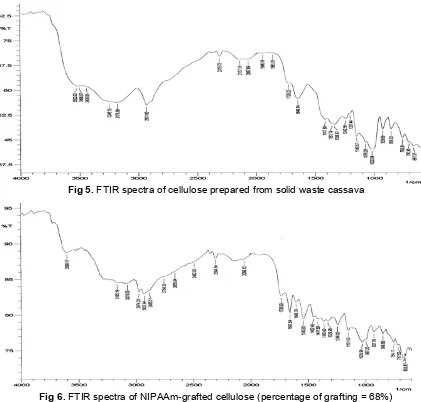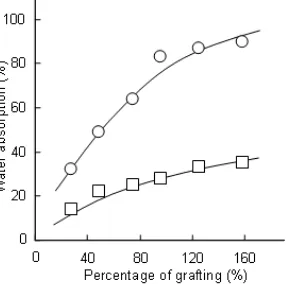PREPARATION OF TEMPERATURE-RESPONSIVE POLYMER BY GRAFTING OF
N-
ISOPROPYLACRYLAMIDE
(NIPAAM) ONTO SOLID WASTE CASSAVA
Irwan Ginting Suka
*
and Wasinton Simanjuntak
Department of Chemistry, Faculty of Mathematics and Natural Sciences, Lampung University, Jl. Sumantri Brojonegoro No. 1 Bandar Lampung, 35144, IndonesiaReceived March 19, 2010; Accepted January 20, 2011
ABSTRACT
In this study, cellulose prepared from solid waste of cassava industry was functionalized with N-isopropylacrylamide (NIPAAm) using grafting technique with the aid of cerium (IV) as initiator, to obtain temperature responsive polymer. In this research, several factors influencing the grafting process and the characteristics of the grafted polymer were investigated, including concentration of monomer and initiator, temperature, reaction time, and solvent used. The functionality of native and grafted cellulose was analyzed using FTIR spectroscopic technique and the response of grafted polymer toward temperature was evaluated with water absorption experiment. Increased concentration of both monomer and initiator was found to promote percentage of polymerization, and utilization of organic solvent was found to enhance the percentage of polymerization. From absorption experiment, it was found that the produced polymer was responsive toward temperature of its environment, as indicated by higher water adsorption at temperature of 5 °C compared to that adsorbed at temperature of 50 °C.
Keywords: Graft copolymerization, solid cassava waste, N-isopropylacrylamide, water absorption, temperature-responsive
INTRODUCTION
Smart polymer is a general term used to describe polymers which have sensitivities toward changes or stimulus from their environments, such as pH, temperature, ions, solvents, electric field. Magnetic field, light, pressure, and biochemical compounds such as glucose [1-3]. Among a variety of polymers known to possess environmental sensitivity, the polymers responsive toward change in pH and temperature are the most widely investigated since these two environmental parameters can change very easy.
Due to their responsive natures, smart polymers are continuously developed with three main forms, including aqueous polymer solution, interfacial polymer, and hydrogel [4]. From these three forms, hydrogel is the most attractive for its very wide application. Several hydrogels are known to exhibit excellent sensitivity toward environment temperatures, such as polymethylvinylether, acryloyl, amino substituted methacryloyl [1], and derivatives of polyacrylamide [5].
Despite its excellent sensitivities, hydrogel is known to have several detrimental properties, primarily low mechanical strength and difficulty to apply as a thin film. To overcome these obstacles, development of smart polymer currently investigate intensively is functionalization of parent polymers with high mechanical strength with hydrogel bearing smart properties. This composite polymer exhibits high
mechanical strength, enabling the processing into form of this film to suit the specific purpose. Among various functionalization techniques exist, grafting is one of the most widely used since application of this method is known to enable the introduction of the specific functional group without affecting the basic structure of the parent polymer [6-8].
In the previous study [9], as an attempt to develop potential utilization of solid waste of cassava industry, the cellulose extracted from this waste was grafted with polymethacrylic acid (polyMAA) to obtain pH-responsive polymer, with the aid of cerium (IV) as initiator. The results obtained from this previous study indicated that the amount of MAA grafted onto cellulose was determined by concentration of both initiator and monomer, as well as the grafting (polymerization) conditions applied. The grafted cellulose was found to exhibit good response to change of the pH of the environment
Fig 1.Molecular structure of polyN-isopropylacrylamide
are presented in Fig. 1.
Hydrogel of polyNIPAAm with cross linking structure in aqueous solution is known to display swelling below LCST and shrinking above the LCST. This phenomenon has attracted many studies for various potential applications, such as sensor, adsorbent, drug delivery, and separation of dissolved materials [11]. Response of the polyNIPAAM-grafted cellulose toward temperature change was determined by measuring the ability of polymer to adsorb water at different temperatures. The original and the grafted cellulose were characterized using FTIR spectroscopic technique to identify the change in the functionality as an indication of polyNIPAAm attachment to the cellulose molecule.
EXPERIMENTAL SECTION
Materials
The chemicals used in this study are N-isopropylacrylamide (WAKO, Japan), cerium (IV) ammonium nitrate, n-hexane, nitric acid, acetone, methanol, aquadest, and silica gel. All chemicals used are reagent grade (GR) or proanalysis (p.a) grade.
Instrumentation
The main equipments used in this study are polymerization glass, magnetic stirrer, water bath, thermometer, hot plate, round bottom flask, and common laboratory glassware.
Procedure
Preparation of cellulose from solid waste cassava Solid waste of cassava industry was obtained from local company (PT. Teguh Wibawa Bhakti Persada), the Province of Lampung. The waste was blended into slurry, and then oven dried at 105 °C for 24 h. Dry waste was then subjected to shake percolation at room temperature for 24 h, using n-hexane as a solvent in order to dissolve non-polar fraction. The solid was filtered out and subjected to second percolation another 24 h using methanol to dissolve polar fraction. The solid was filtered out and oven dried at 60 °C.
Graft copolymerization of N-isopropylacrylamide on solid waste cassava
The typical experiment was carried out by transferring 0.5 g of dried cellulose into polymerization glass, followed by addition of 24 mL of preheated aquadest, 5 mL nitric acid containing Ce4+ ion and certain volume of aqueous solution of NIPAAm to satisfy specified concentration. The glass was covered and vacuum-pumped followed by flowing of nitrogen gas. This treatment was repeated three times. Polymerization grafting was carried out at 50 °C with varying concentrations of initiator and monomer (NIPAAm). Experiments were carried out in two different solvents, namely water and methanol-water (5% v/v).
After the completion of reaction, the sample was immersed in water at room temperature for 72 h, during which the water was replaced every 6 h to wash out any homopolymer and unreacted monomer, since NIPAAm and PolyNIPAAm are readily dissolved in cold water [12-13]. To ensure the complet removal of water, the sample was subjected to extraction using acetone. Extraction was conducted at 60 °C for 2 h, and then the sample was dried again to remove the acetone. The amount of polyNIPAAm grafted onto cellulose, defined as percentage of grafting, was calculated based on the mass of cellulose before (Wo) and after grafting (Wg),
according to the equation:
g o o
W - W
Percentage of Grafting (%) = x 100
W (1)
Polymers with different percent of grafting were prepared by varying the concentration of polyNIIPAAm and reaction times.
Characterization using FTIR spectroscopic technique
Characterization of sample using this technique was carried out to follow the change in the functionality of cellulose as a result of grafting. Attachment of polyNIPAAm is expected to produce absorption bands at 1624 and 1543 cm-1, representing the presence of amide functional group.
Determination of temperature response characteristic
Response of polyNIPAAm-grafted cellulose toward temperature change was determined by measuring the water absorption capacity of the sample at different temperatures. For this purpose, a certain mass (Wg, g) of sample was transferred into tea bag of
Fig 2. The effect of initiator concentration and reaction time on percentage of grafting at 50 °C. [Ce4+] : (Δ) 10 mmol/L, (□) 5 mmol/L
Fig 3. Effect of monomer concentration on the percentage of grafting. Reaction was carried out at 50 °C for 30 min and [Ce4+] = 5 mmol/L. Solvent (○) Methanol -water (5%v/v), (□) -water
Fig 4. Effect of temperature on the percentage of grafting. [NIPAAm] = 0.79 M, [Ce4+] = 5 mmol/L. Temperature: (□) 50 °C and (Δ) 30°C
the sample. The sample was taken out from the bag and was weight to obtain the mass of sample (W1). Water
absorption capacity was calculated using the following equation:
2 1 1
W - W
Water Absorption (%) = x 100
W (2)
RESULT AND DISCUSSION
Grafting of PolyNIPAAm onto cellulose
Cellulose is hydrophilic polymer bearing three reactive hydroxyl groups per unit of hydroglucose. This polymer is composed of thousands anhydroglucose connected by 1,4-β-glucoside bond, to produce long and linear chained molecule [14]. The presence of this hydroxyl group is the main principle for modification of cellulose by introduction of functional group with specific properties using grafting method [15]. Attachment of monomers has been known to improve the characteristics of cellulose, such as elasticity, absorption capacity toward water and dye [14], hydrophilic and hydrophobic degree [12], ion exchange capacity [16], and thermal stability [17].
In this study, cellulose obtained from solid cassava waste was grafted with polyN-isopropylacrylamide (polyNIPAAm) using Ce4+ as initiator, with the aims to investigate the role of several variables on the amount of polyNIPAAm grafted (the percentage of grafting) and temperature responsive property of the grafted cellulose produced. The effects of initiator concentration and reaction time were investigated by performing the experiments using [Ce4+] = 5 mmol/L and 10 mmol/L, at different reactions times. The results obtained are presented in Fig. 2.
As can be seen, the effects of both initiator concentration and reaction time are very evident, in which the percentage of grafting was found to increase with increased concentration of Ce4+ ion and reaction time. This result not only indicates that the grafting proceeded easily, but it also suggested that the percentage of grafting can be adjusted by using these two variables.
The effect of monomer (NIPAAm) concentration on the percentage of grafting in two different solvents, water and methanol-water (5% v/v), is displayed by the results presented in Fig. 3. As shown by the results in Fig. 3, the effect of solvent is very obvious, in which the percentage of grafting is significantly higher in methanol-water than that obtained in water alone. In term of monomer concentration, the trends in both solvents are practically similar, in which increased monomer concentration lead to higher percentage of grafting.
(3)
(4)
(5)
molecules which eventually resulted in higher percentage of grafting. In addition, inclusion of methanol as a solvent is believed to increase the permeability of
polyNIPAAm, enabling them to penetrate the cellulose molecules more easily. This is in accordance with the previous reports which describes that the solvent composed of methanol and water with proper ratio resulted in higher solubility of NIPAAm than that in water and methanol alone [13,19].
As mentioned previously, the lower critical solution temperature (LCST) for NIPAAm is 32 °C [6,10]. To investigate the effect of temperature on the reactivity of NIPAAm, the experiments were carried out at 30 and 50 °C, and the results obtained are presented in Fig. 4. As displayed by Fig. 4, the effect of temperature is very evident in governing the reactivity of NIPAAm. In general it could be seen that the reactivity of NIPAAm at temperature of 50 °C is much higher, leading to sharp increase in percentage of grafting in short time. Increased temperature is acknowledged to increase the rate of diffusion of the monomer and the rate of termination of growing chain. Higher temperature has also been reported to suppress the effect of gel on radical mobility [20].
Fig. 4 also demonstrated that grafting at 30 °C requires induction time up to 60 min, during which the percentage of grafting is practically negligible. This induction time is followed by a significant rate of reaction up to the completion of the experiment at 240 min.
Graft polymerization of polyNIPAAm onto cellulose could be described as follows. Solution of cerium salts, such as cerium nitrate and cerium sulphate are known to act as strong oxidizing agent in the presence of organic reducing agents, such alcohol, thiol, glycol, aldehyde, and amine [21]. With the use of Ce4+, as initiator, the grafting is initiated by the reaction between the initiator and the cellulose molecule to produce radical at hemiacetal or glycol chain of the cellulose molecule (Eq. 3). The cellulose radical then react with NIPAAm to produce another radical (Eq. 4) which continue to react with other molecules of NIPAAm (Eq. 5) to eventually produce polyNIPAAM on the surface of the cellulose [15].
Characterization of samples using FTIR Spectroscopy
One way to evaluate the successful grafting of polyNIPAAm onto cellulose is by comparing the functionality of the original cellulose with that of the grafted cellulose. For this purpose, the original cellulose and grafted cellulose with percentage of grafting = 68% were characterized using FTIR spectroscopic technique.
Fig 5.FTIR spectra of cellulose prepared from solid waste cassava
Fig 6.FTIR spectra of NIPAAm-grafted cellulose (percentage of grafting = 68%)
bearing hydroxyl group, indicated by the broad absorption band at around 3400 cm-1. The spectra are also marked by the presence of spectral bands in the range of 858 – 1020 cm-1, which are characteristic of aloxy group of cellulose.
The FTIR spectra of grafted cellulose is presented in Fig. 6. The most obvious characteristic of the spectra which distinguished it from the spectra of the original cellulose is the presence of absorption bands at 1543 and 1624 cm-1, which indicate the presence of amide group of the polyNIPAAm. The presence of these spectral bands then can be considered to support the grafting of polyNIPAAm onto cellulose.
Temperature responsive of polyNIPAAm-grafted cellulose
As described before, hydrogel of polyNIPAAm with cross-linking structure in aqueous solution will swell
below its lower critical solution temperature (LCST), which is around 32 °C, and shrink above this [6,10]. This property is resulted from reversible breakage and formation of hydrogen bond between NH or C=O group in polyNIPAAM and the surrounding water molecules when temperature slightly change [10]. With this property, it is the expected that the grafted polyNIPAAm on cellulose film will display sensitivity toward temperature of the environment which could be measured by water absorption capacity of the grafted cellulose due to increased hydrophilicity of the NIPAAm-grafted cellulose [12,22].
Fig 7. Water absorption capacity of NIPAAm-grafted cellulose as a function of temperature. Percentage of grafting = 158%
Fig 8. Water absorption capacity of NIPAAm-grafted cellulose as a function of percentage of grafting at two temperatures, (○) 5 °C and (□) 50 °C
constant at higher temperatures up to 60 °C.
To evaluate the correlation between the percentage of grafting and the water absorption capacity, the water absorption experiments were also carried out using grafted cellulose with different percentages of grafting. The absorption experiments were conducted at 5 and 50 °C, producing the results presented in Fig. 8.
As can be seen, increased absorption capacity with increased percentage of grafting is evident. It is also evident that temperature is strongly affecting the capacity of the sample to absorb water, in which lower temperature led to higher absorption capacity. This trend is most likely due to formation of more hydrogen bonds between NH or C=O group and the surrounding water at lower temperature [10].
CONCLUSION
From a series of experiments carried out in this study, it is concluded that graft polymerization of N-isopropylacrylamide (NIPAAm) onto cellulose extracted
from solid waste cassava could be achieved using cerium (IV) as initiator. The water absorption experiments demonstrated that the resulting NIPAAm-grafted films were characterized by a temperature-responsive character, where the grafted films swelled and shrank at 5 °C and 50 °C, respectively. The temperature sensitivity of the produced polymers was found to be influenced by the percentage of grafting and solvent uses.
ACKNOWLEDGEMENT
The authors wish to thank and appreciate Directorate of Higher Education, Department of National Education, Republic of Indonesia, for financial support through research grand (Hibah Bersaing XV Tahun Anggaran 2007).
REFERENCES
1. Chen, J., Yoshida, M., Maekawa, Y., and Tsubokawa, N., 2001, Polymer, 42, 23, 9361– 9365.
2. Kim, B., and Peppas, N.A., 2002,J. Biomater. Sci., Polym.Ed., 13, 11, 1271–1283.
3. Chansook, N., and Kiatkamjornwong, S., 2003. J. Appl. Polym. Sci., 89, 7, 1952–1958.
4. Peppas, N.A., 2000,Intelligent Hydrogels and their Biotechnological and Separation Applications. Radiation Synthesis of Intelligent Hydrogels and Membranes for Separation Purposes. G. Güven, ed., IAEA, Vienna, 1–14.
5. Langer, R., and Peppas, N.A., 2003,AIChE J., 49, 12, 2990–3006.
6. Virtanen, J., Baron, C., and Tenhu, H., 2000, Macromolecules, 33,4, 336–341.
7. Nakajima, T., Kubota, H., and Katakai, R., 2000,J. Macromol. Sci., Pure Appl. Chem., A37, 3, 205– 214.
8. Irwan, G.S., Kuroda, S., Kondo, T., and Kubota, H., 2004,Eur. Polym. J., 40, 6, 171–179.
9. Irwan, G.S, Simanjuntak, W., and Widiarto, S., 2007,J. Sains MIPA, 13, 2, 107–113.
10. Tsuda, Y., Kikuchi, A., Yamato, M., Yasuhisa, S., and Mitsuo, U., 2004,J. Biomed. Mater. Res. Part A,69A, 1, 70–78.
11. Wang, W.C., Ong, G.T., Lim, S.L., Vora, R.H., Kang, E.T., and Neoh, K.G., 2003,Ind. Eng. Chem. Res.42, 14, 3740–3749.
12. Xie, J., and Hsieh, Y.L., 2003,J. Appl. Polym. Sci., 89, 3, 999–1006.
13. Irwan, G.S., Kuroda, S., Kondo, T., and Kubota, H., 2002,J. Appl. Polym. Sci.,87, 14, 2454–2461. 14. Helbreich, A., and Guthrie, J.T., 1981, The
15. Kubota, H., and Shiobara, N., 1998, React. Funct. Polym.,37, 3, 219–224.
16. Güclü, G., Gürdağ G., and Özgümüs, S., 2003, J. Appl. Polym. Sci., 90, 8, 2034–2039.
17. Abdel-Mohdy, F.A., 2003,J. Appl. Polym. Sci., 89, 9, 2573–2578.
18. Brandrup, J., and Immergut, E.H., 1989, Polymer Handbook,Eds.; Wiley: New York, IV–344.
19. Schild, H.G., Muthukumar, M., and Tirrell, D.A., 1991,Macromolecules, 24, 4, 948–952.
20. Yang, B., and Yang, W.T., 2003, J. Membr. Sci., 218, 1-2, 247–255.
21. Borbély, É., 2005, Acta Polytech. Hung., 2, 2, 67– 76.
